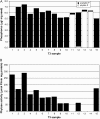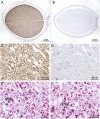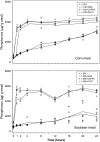Quantitative conversion of phytate to inorganic phosphorus in soybean seeds expressing a bacterial phytase
- PMID: 18162589
- PMCID: PMC2245832
- DOI: 10.1104/pp.107.113480
Quantitative conversion of phytate to inorganic phosphorus in soybean seeds expressing a bacterial phytase
Abstract
Phytic acid (PA) contains the major portion of the phosphorus in the soybean (Glycine max) seed and chelates divalent cations. During germination, both minerals and phosphate are released upon phytase-catalyzed degradation of PA. We generated a soybean line (CAPPA) in which an Escherichia coli periplasmic phytase, the product of the appA gene, was expressed in the cytoplasm of developing cotyledons. CAPPA exhibited high levels of phytase expression, >or=90% reduction in seed PA, and concomitant increases in total free phosphate. These traits were stable, and, although resulted in a trend for reduced emergence and a statistically significant reduction in germination rates, had no effect on the number of seeds per plant or seed weight. Because phytate is not digested by monogastric animals, untreated soymeal does not provide monogastrics with sufficient phosphorus and minerals, and PA in the waste stream leads to phosphorus runoff. The expression of a cytoplasmic phytase in the CAPPA line therefore improves phosphorus availability and surpasses gains achieved by other reported transgenic and mutational strategies by combining in seeds both high phytase expression and significant increases in available phosphorus. Thus, in addition to its value as a high-phosphate meal source, soymeal from CAPPA could be used to convert PA of admixed meals, such as cornmeal, directly to utilizable inorganic phosphorus.
Figures




Similar articles
-
Ectopic expression of a soybean phytase in developing seeds of Glycine max to improve phosphorus availability.Plant Mol Biol. 2004 Dec;56(6):895-904. doi: 10.1007/s11103-004-5293-6. Epub 2005 Apr 7. Plant Mol Biol. 2004. PMID: 15821988
-
Production of two highly active bacterial phytases with broad pH optima in germinated transgenic rice seeds.Transgenic Res. 2004 Feb;13(1):29-39. doi: 10.1023/b:trag.0000017158.96765.67. Transgenic Res. 2004. PMID: 15070073
-
Overexpression of phyA and appA genes improves soil organic phosphorus utilisation and seed phytase activity in Brassica napus.PLoS One. 2013;8(4):e60801. doi: 10.1371/journal.pone.0060801. Epub 2013 Apr 3. PLoS One. 2013. PMID: 23573285 Free PMC article.
-
Advances in phytase research.Adv Appl Microbiol. 2000;47:157-99. doi: 10.1016/s0065-2164(00)47004-8. Adv Appl Microbiol. 2000. PMID: 12876797 Review.
-
Phytate and phytase in fish nutrition.J Anim Physiol Anim Nutr (Berl). 2012 Jun;96(3):335-64. doi: 10.1111/j.1439-0396.2011.01169.x. Epub 2011 Jun 21. J Anim Physiol Anim Nutr (Berl). 2012. PMID: 21692871 Review.
Cited by
-
Seed targeted RNAi-mediated silencing of GmMIPS1 limits phytate accumulation and improves mineral bioavailability in soybean.Sci Rep. 2019 May 23;9(1):7744. doi: 10.1038/s41598-019-44255-7. Sci Rep. 2019. PMID: 31123331 Free PMC article.
-
Molecular Mechanisms and Biochemical Pathways for Micronutrient Acquisition and Storage in Legumes to Support Biofortification for Nutritional Security.Front Plant Sci. 2021 Jun 7;12:682842. doi: 10.3389/fpls.2021.682842. eCollection 2021. Front Plant Sci. 2021. PMID: 34163513 Free PMC article. Review.
-
Ensifer meliloti overexpressing Escherichia coli phytase gene (appA) improves phosphorus (P) acquisition in maize plants.Naturwissenschaften. 2016 Oct;103(9-10):76. doi: 10.1007/s00114-016-1400-1. Epub 2016 Sep 5. Naturwissenschaften. 2016. PMID: 27597170
-
Transgenic soybean expressing a thermostable phytase as substitution for feed additive phytase.Sci Rep. 2019 Oct 7;9(1):14390. doi: 10.1038/s41598-019-51033-y. Sci Rep. 2019. PMID: 31591515 Free PMC article.
-
Impacts of elevated atmospheric CO₂ on nutrient content of important food crops.Sci Data. 2015 Jul 21;2:150036. doi: 10.1038/sdata.2015.36. eCollection 2015. Sci Data. 2015. PMID: 26217490 Free PMC article.
References
-
- Association of Official Seed Analysts (1993) Rules for testing seeds. Journal of Seed Technology 16 1–113
-
- Bregitzer P, Raboy V (2006) Effects of four independent low-phytate mutations on barley agronomic performance. Crop Sci 46 1318–1322
-
- Chanprame S, Kuo TM, Widholm JM (1998) Soluble carbohydrate content of soybean (Glycine max (L.) Merr.) somatic and zygotic embryos during development. In Vitro Cell Dev Biol Plant 34 64–68
-
- Chappell AS, Scaboo AM, Wu X, Nguyen H, Pantalone VR, Bilyeu KD (2006) Characterization of the MIPS gene family in Glycine max. Plant Breed 125 493–500
-
- Chen QC, Li BW (2003) Separation of phytic acid and other related inositol phosphates by high-performance ion chromatography and its applications. J Chromatogr A 1018 41–52 - PubMed
Publication types
MeSH terms
Substances
LinkOut - more resources
Full Text Sources
Other Literature Sources

